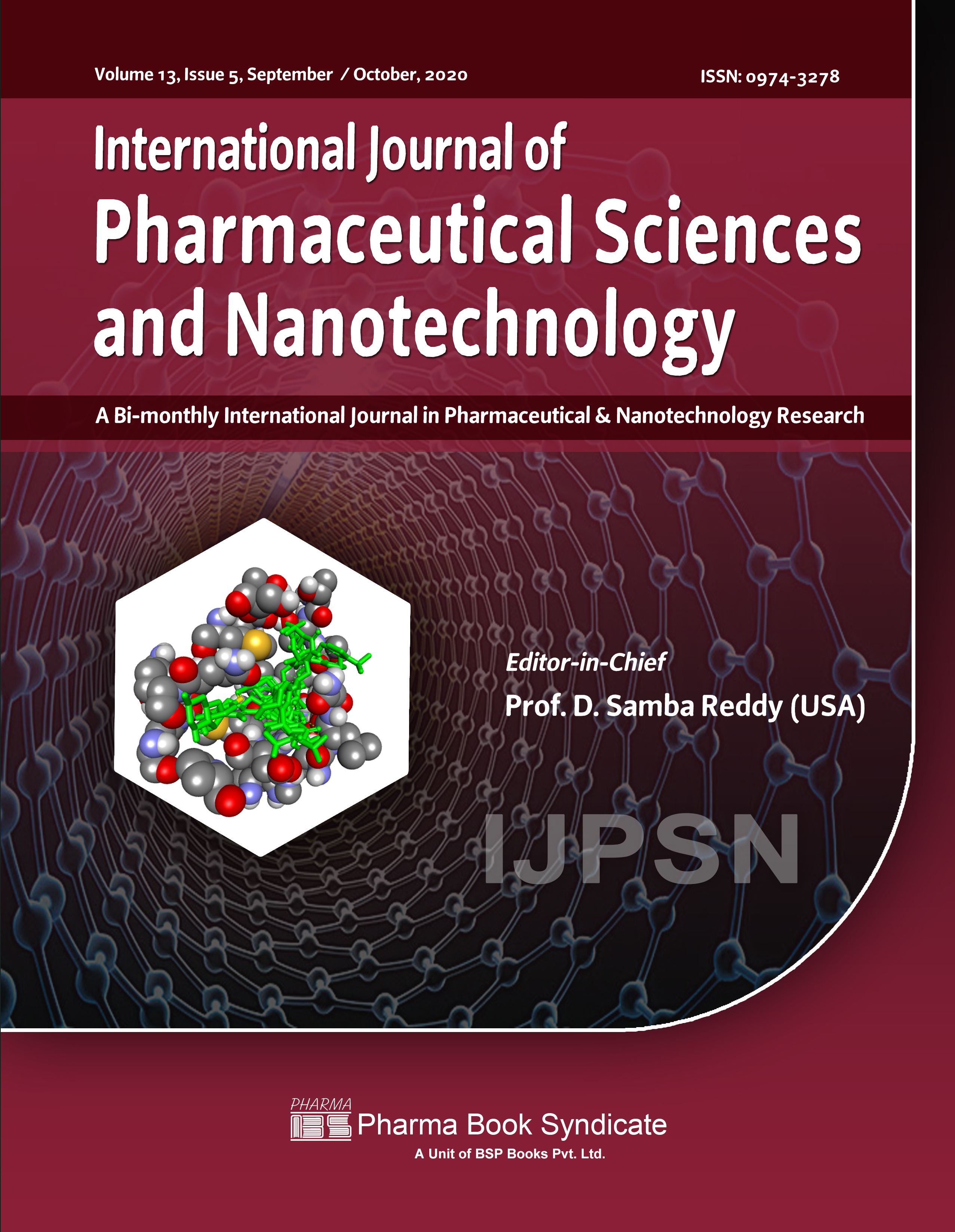Doxorubicin Loaded Nanoparticle Consisting of Chitosan and Mannose Modified Graphene Oxide for Intracellular Drug Delivery and Anti-tumor Activity
DOI:
https://doi.org/10.37285/ijpsn.2020.13.5.13Abstract
In order to develop the efficiency and the specificity of anticancer drug delivery, we have designed an innovative nanocarrier. The nanocarrier system comprises of a multifunctional graphene oxide nanoparticle-based drug delivery system (GO-CS-M-DOX) as a novel platform for intracellular drug delivery of doxorubicin (DOX). Firstly, graphene oxide (GO) was synthesized by hummer’s method whose surface was functionalized by chitosan (CS) in order to obtain a more precise drug delivery, the system was then decorated with mannose (M). Further conjugation of an anti-cancer drug doxorubicin to the nanocarrier system resulted in GO-CS-M-DOX drug delivery system. The resultant conjugate was
characterized for its physio-chemical properties and its biocompatibility was evaluated via hemolysis assay. The drug entrapment efficiency is as high as 90% and in vitro release studies of DOX under pH 5.3 is significantly higher than that under pH 7.4. The anticancer activity of the synthesized drug delivery system was studied by 3-(4, 5-dimethylthiazol-2-yl)-2,5-diphenyl-tetrazolium bromide (MTT) assay against MCF-7 cell line. These results stated that the pH dependent multifunctional doxorubicin- chitosan functionalized graphene oxide based nanocarrier system, could lead to a promising and potential platform for intracellular delivery and cytotoxicity activity for variety of anticancer drugs.
Downloads
Metrics
Keywords:
Graphene oxide, Chitosan, Mannose, Doxorubicin, pH dependent, Drug releaseDownloads
Published
How to Cite
Issue
Section
References
Adair J H, Parette M P, Altınoglu E I, and Kester M (2010). Nano particulate alternatives for drug delivery. ACS Nano 4(9):4967–4970.
Ali-Boucetta H, Al-Jamal K T, McCarthy D, Prato M, Bianco A and Kostarelos (2008). Multi walled carbon nanotube-doxirubicin supramolecular complexes for cancer therapeutics. Chem Communications (4):459-461.
Bao H, Pan Y, Ping Y, Sahoo N G, Wu T, Li L (2011). Chitosan functionalized graphene oxide as nanocarrier for drug and gene delivery.Small 7(11): 1569–1578.
Chen W, Meng F, Cheng R, Zhong Z (2010). pH –Sensitive degradable polymersomes for triggered release of anticancer drugs: A comparative study with micelles.J Control Release 142(1): 40–46.
Cheng J, Fernando K A S, Fernando L M, Veca Y P, Lamond A I, KAm Y W, Cheng S H(2008). Reversible accumulation of PEGylated single-walled carbon nanotubesin the mammalian nucleus.ACS Nano 2:2085–2094.
Fehrenbacher N and Jaattela M (2005).Lysosomes targets for cancer theraphy. Cancer Res 65(8): 2993–2995.
Geim AK, Novoselov KS. The rise of graphene. Nat Mater 2007:6:183–91.
Guo Z , Li D D , Luo X K , Li Y H ,Zhao Q N, Li M M, Zhao Y T, Sun T S and Ma C (2017) .Simultaneous determination of trace Cd(II), Pb(II) and Cu(II) by differential pulse anodic stripping voltammetry using a reduced graphene oxide-chitosan/poly-l-lysine nanocomposite modified glassy carbon electrode.J.Colloid Interface Sci 15(490):11-22.
Huihui Yang, David H Bremner, Lei Tao, Heyu Li, Juan Hu, Limin Zhu (2016). Carboxymethyl chitosan –mediated synthesis of hyaluronic acid targeted graphene oxide for cancer drug delivery 135:72-78
Hummers W S,Offeman R E(1958). Preparation of graphitic oxide. J. Am. Chem. Soc 80(6)1339.
Jayakumar R, Prabaharan M, Sudheesh Kumar PT, Nair SV, Tamura H(2011). Biomaterials based on chitin and chitosan in wound dressing applications. Biotechnology advances 29(3):322–337.
Ken-Hsuan Liao,Yu-Shen Lin,Christopher W Macosko and Christy L Hanes(2011).Cytotoxicity of Graphene Oxide and Graphene in Human Erythrocytes and Skin Fibroblasts.ACS Appl.Mater.Interfaces 3(7):2607-2615.
Lee WC, Lim CH, Shi H, Tang LA, Wang Y, Lim CT (2011).Origin of enhanced stem cell growth and differentiation on graphene and graphene oxide. ACS Nano 5(9):7334–41.
Li L, Zhang R, Gu W, Xn Z P (2018). Mannose- conjugated layered double hydroxide nanocomposite for targeted siRNA delivery to enhance theraphy. Nanomedicine 14(7):2355-2364.
Mitchell JP, Roberts DR, Langley J, Koentgen F, Lambert JN (1999). A direct method for the formation of peptide and carbohydrate dendrimers. Bio org Med Chem Lett 9:2785-2788.
Mosmann T (1983). Rapid colorimetric assay for cellular growth and survival: application to proliferation and cytotoxicity assays. J.Immunol.Methods 65(1-2): 55–63.
Nethravathi C, Rajamathi J T, Ravishankar N, Shivakumara C, Rajamathi M(2008). Graphite oxide intercalated anionic clay and its decomposition to graphene. Inorganic material nanocomposites. Langmuir 24:8240–8244.
Orecchioni M, Cabizza R, Bianco A, Delogu L G (2015). Graphene as cancer theranostic tool: progress and future challenges.Theranostics 5:710–723.
Peer D, Karp J M, Hong S, FaroKhzad O C, Margalit R, and Langer R (2007).Nanocarriers as an emerging platform for cancer therapy. Nature Nanotechnology 2(12):751–760.
Perera S D, Mariano R G, Vu K (2012) Hydrothermal synthesis of graphene-TiO2 nanotube composites with enhanced photocatalytic activity ACS Catalysis 2(6): 949–956.
Pommier Y, Leo E, Zhang H, Marchand C(2010).DNA topoisomerases and their poisoning by anticancer and antibacterial drugs. Chem Biol 17(5):421-433.
Salim M, Minamikawa H, Sugimura A, and Hashim R (2014). Amphiphilic designer nano-carriers for controlled release: from drug delivery to diagnostics. Med Chem Comm 5(11): 1602–1618.
Shen J, Yan B, Shi M, Ma H, Li N, Ye M (2011). Synthesis of graphene oxide-based biocomposites through diimide-activated amidation. J Colloid Interf Sci 356(2):543–549.
Srivastava A, Yadav T, Sharma S, Nayak A, Kumari A, Mishra N(2016). Polymers in drug delivery. J. Biosci. Med 4:69–84.
Thangavel Muthukumarasamyvel, Raju Baskar, Shanmugam Chandirasekar, Kesavachandran Umamaheswari and Nagappan Rajendiran(2016). Hierarchical Self-Assembly of Bile-Acid-Derived Dicationic Amphiphiles and Their Toxicity Assessment on Microbial and
Mammalian Systems.ACS.Appl.Mater.Interfaces 8:25111-25126
Wang Y, Li Z, Wang J, Li J, Lin Y(2011).Graphene and graphene oxide: biofunctionalization and applications in biotechnology. Trends Biotechnol 29(5):205–12.
Wang SF, Shen L, Zhang WD and Tong YJ (2005). Preparation and mechanical properties of chitosan/carbon nanotubes composites. Biomacromolecules 6(6):3067-3072.
Yih T C and Al-Fandi M (2006). Engineered nanoparticles as precise drug delivery systems. Journal of Cellular Biochemistry, 97(6):1184–1190.
Zhang Q, Cai Y, Wang X J, Xu J L, Ye Z, Wang S, Seeberger P H, Yin J(2016).Targeted photodynamic killing of breast cancr cells emplying hepatomannosylated β-cyclodextrin-mediated nanoparticle formation of an adamantine-functionalized BODIPY photosensitizer. J. ACS Appl Mater Interfaces 14(8):33405-33411
Zhao X, Zhang Q, Hao Y, Li Y, Fang Y, Chen D (2010). Alternate multilayer films of poly (vinyl alcohol) and exfoliated graphene oxide fabricated via a facial layer-by-layer assembly. Macromolecules 43(226):9411–9416.






